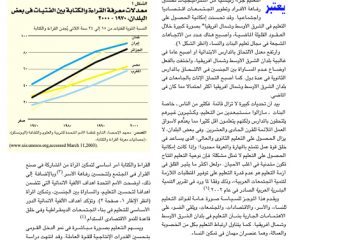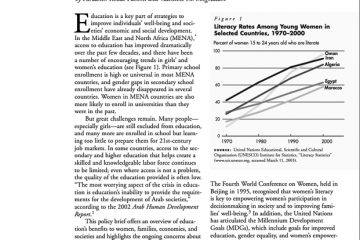
Empowering Women, Developing Society: Female Education in the Middle East and North Africa
This report is in Arabic and English.
Date
November 20, 2003
Authors
Farzaneh Roudi-Fahimi
Former Director, Middle East and North Africa
Valentine Moghadam
Professor, Illinois State University
Focus Areas
Education is a key part of strategies to improve individuals’ well-being and societies’ economic and social development. In the Middle East and North Africa (MENA) (countries and territories included in the Middle East and North Africa as defined here are listed in Table 1), access to education has improved dramatically over the past few decades, and there have been a number of encouraging trends in girls’ and women’s education (see Figure 1). Primary school enrollment is high or universal in most MENA countries, and gender gaps in secondary school enrollment have already disappeared in several countries. Women in MENA countries are also more likely to enroll in universities than they were in the past.
Table 1
Selected Socioeconomic Indicators in the Middle East and North Africa
| Percent of Population Over Age 15 Who Are Illiterate, 2000 | Number of People Over Age 15 Who Are Illiterate (thousands), 2000 | Percent of Population Ages 15 to 24 Who Are Illiterate, 2000 | Number of People Ages 15 to 24 Who Are Illiterate (thousands), 2000 | |||||
|---|---|---|---|---|---|---|---|---|
| Female | Male | Female | Male | Female | Male | Female | Male | |
| Middle East and North Africa | 42 | 22 | 50,057 | 26,671 | 23 | 11 | 8,585 | 4,573 |
| Algeria | 43 | 24 | 4,211 | 2,360 | 16 | 7 | 530 | 227 |
| Bahrain | 17 | 9 | 32 | 25 | 1 | 2 | 1 | 1 |
| Egypt | 56 | 33 | 12,253 | 7,374 | 37 | 24 | 2,500 | 1,678 |
| Iran | 31 | 17 | 6,696 | 3,819 | 9 | 4 | 655 | 296 |
| Iraq | 77 | 45 | 5,070 | 3,057 | 71 | 41 | 1,593 | 962 |
| Jordan | 16 | 5 | 220 | 78 | 1 | 1 | 3 | 5 |
| Kuwait | 20 | 16 | 103 | 130 | 7 | 8 | 15 | 19 |
| Lebanon | 20 | 8 | 246 | 91 | 7 | 3 | 23 | 9 |
| Libya | 32 | 9 | 533 | 168 | 7 | 0.5 | 43 | 1 |
| Morocco | 64 | 38 | 6,286 | 3,702 | 42 | 24 | 1,265 | 750 |
| Oman | 38 | 20 | 246 | 155 | 4 | 0.5 | 9 | 1 |
| Palestine* | 16 | 6 | 136 | 48 | — | — | — | — |
| Qatar | 17 | 20 | 21 | 57 | 3 | 7 | 1 | 3 |
| Saudi Arabia | 33 | 17 | 1,723 | 1,092 | 10 | 5 | 187 | 101 |
| Syria | 40 | 12 | 1,879 | 566 | 21 | 5 | 376 | 85 |
| Tunisia | 39 | 19 | 1,307 | 621 | 11 | 3 | 106 | 27 |
| Turkey | 24 | 7 | 5,453 | 1,539 | 6 | 1 | 392 | 81 |
| United Arab Emirates | 21 | 25 | 117 | 345 | 6 | 13 | 10 | 29 |
| Yemen | 75 | 33 | 3,525 | 1,444 | 54 | 17 | 874 | 292 |
* Palestine inclues the Arab population of the West Bank and Gaza.
Sources: UNESCO Institute for Statistics, “Literacy Statistics” (www.uis.unesco.org, accessed March 11, 2003); United Nations Development Programme, Human Development Report 2002; UN Statistics Division, The World’s Women 2000: Trends and Statistics (http://unstats.un.org/unsd/demographic/ww2000/table5d.htm, accessed Aug. 23, 2003); F. Roudi-Fahimi, “Women’s Reproductive Health in the Middle East and North Africa” (2003); and C. Haub, 2003 World Population Data Sheet.
Figure 1 Literacy Rates Among Young Women in Selected Countries, 1970-2000
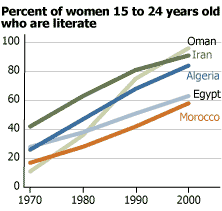
Source: United Nations Educational, Scientific and Cultural Organization (UNESCO) Institute for Statistics, “Literacy Statistics” (www.uis.unesco.org, accessed March 11, 2003).
But great challenges remain. Many people — especially girls — are still excluded from education, and many more are enrolled in school but learning too little to prepare them for 21st-century job markets. In some countries, access to the secondary and higher education that helps create a skilled and knowledgeable labor force continues to be limited; even where access is not a problem, the quality of the education provided is often low. ” The most worrying aspect of the crisis in education is education’s inability to provide the requirements for the development of Arab societies,” according to the 2002 Arab Human Development Report.1
This policy brief offers an overview of education’s benefits to women, families, economies, and societies and highlights the ongoing concerns about education in MENA countries. It also looks at education’s links with fertility and employment, two important elements in women’s empowerment.
Education: A Social Right and a Development Imperative
Education’s importance has been emphasized by a number of international conventions, including the Universal Declaration of Human Rights and the Programme of Action of the 1994 International Conference on Population and Development.2 The Fourth World Conference on Women, held in Beijing in 1995, recognized that women’s literacy is key to empowering women’s participation in decisionmaking in society and to improving families’ well-being.3 In addition, the United Nations has articulated the Millennium Development Goals (MDGs), which include goals for improved education, gender equality, and women’s empowerment (see Box 1 at end of article). The MDGs emphasize education’s essential role in building democratic societies and creating a foundation for sustained economic growth.4
Education contributes directly to the growth of national income by improving the productive capacities of the labor force. A recent study of 19 developing countries, including Egypt, Jordan, and Tunisia, concluded that a country’s long-term economic growth increases by 3.7 percent for every year the adult population’s average level of schooling rises.5 Thus, education is a key strategy for reducing poverty, especially in the MENA region, where poverty is not as deep as in other developing regions.6 According to the United Nations Population Fund, countries that have made social investments in health, family planning, and education have slower population growth and faster economic growth than countries that have not made such investments.7
In the increasingly open global economy, countries with high rates of illiteracy and gender gaps in educational attainment tend to be less competitive, because foreign investors seek labor that is skilled as well as inexpensive. Various global trends pose special challenges to women who are illiterate or have limited education. Economies’ export orientation and the growing importance of small and medium-sized enterprises create opportunities for women, but women need the appropriate education and training to take full advantage of these opportunities.
In addition, the benefits of female education for women’s empowerment and gender equality are broadly recognized:
- As female education rises, fertility, population growth, and infant and child mortality fall and family health improves.
- Increases in girls’ secondary school enrollment are associated with increases in women’s participation in the labor force and their contributions to household and national income.
- Women’s increased earning capacity, in turn, has a positive effect on child nutrition.8
- Children — especially daughters — of educated mothers are more likely to be enrolled in school and to have higher levels of educational attainment.
- Educated women are more politically active and better informed about their legal rights and how to exercise them.
Cultural and Economic Factors That Reinforce the Gender Gap
MENA countries generally have lower levels of women’s education and labor force participation than other regions with similar income levels. The interaction between the region’s economic structure and its conservative culture, in which traditional gender roles are strongly enforced, is largely responsible.9 Men in the MENA region are more likely to have direct access to wage employment and control over wealth, while women are largely economically dependent upon male family members.
The region’s oil-based economy, which produced tremendous wealth in some MENA countries, reinforces the region’s gender roles. In a number of MENA countries, the use of capital-intensive technologies that require few workers, along with relatively high wages for men, have precluded women’s greater involvement in the labor force.10 Women’s employment options have been limited to a small number of socially acceptable occupations and professions, such as teaching and medicine. In the Gulf states, jobs not considered appropriate for MENA women, such as waitressing, are often filled by imported female laborers from South and East Asia.
Gender discrimination in the MENA region is sometimes codified in law, frequently in family laws or civil codes. In many countries in the region, women must obtain permission from a male relative, usually a husband or father, before seeking employment, requesting a loan, starting a business, or traveling. Such laws often grant women a smaller share of inherited family wealth. As a result, families tend to make greater investments in education for boys than for girls.
The results of Egypt’s 2000 Demographic and Health Survey (DHS) provide insights into families’ preferences for investing in their children’s education. Women with children ages 6 to 15 were asked, “If parents have one son and one daughter and can send only one child to the university, which child should they send?” While 53 percent of the women said that the decision should depend on the children’s capabilities, 39 percent said that the son should go to the university, compared with only 8 percent who said that the daughter should go. The survey also found that mothers of children who had never attended school were more likely to cite the cost of education as a reason for not educating their daughters than for not educating their sons.11
However, the situation in the region is slowly changing. Women activists, who generally come from the educated segments of society, are challenging the status quo; demanding equality in the family and society; and calling for women’s economic, political, and social empowerment. The trend’s intensity varies by country but is visible even in relatively conservative nations. In addition to facing political pressure for reform, countries are dealing with economic changes that are creating an impetus for women to become more active outside the home. As the region’s cost of living rises rapidly, families are increasingly forced to depend on the additional income that female family members can provide.
Education’s Effects on Reproductive Choices and Employment
Education helps women take advantage of opportunities that could benefit them and their families, preparing women for the labor force and helping them understand their legal and reproductive rights.
Fertility
Education is the single most important determinant of both age at marriage and age at first birth in MENA countries, since women in the region tend to give birth soon after marriage. Among married Egyptian women ages 25 to 29, for instance, those with no education had married at age 18, on average, and had their first child by age 20; those with a secondary or higher education married at an average age of 23 and had their first child by age 25.12 Turkey’s 1998 DHS showed that 22 percent of girls 15 to 19 years old who had no education or who had not completed primary school were already mothers or pregnant, compared with only 2 percent of girls who had completed secondary or higher education.13
Educated women generally want smaller families and make better use of reproductive health and family planning information and services in achieving their desired family size; Moroccan women with at least some secondary education had, on average, half as many children as women with no education (see Figure 2). Women with more education also tend to have healthier families. In Egypt, for example, children born to mothers with no formal education were more than twice as likely to die as those born to mothers who had completed secondary school (see Figure 3). According to the 2000 DHS, Egyptian women with less education were less likely to receive antenatal care: Only 34 percent of Egyptian mothers with no education received antenatal care, compared with 75 percent of those with a high school or college degree.14
Figure 2
Contraceptive Use and Fertility in Morocco, by Women’s Education, 1995

Source: ORC Macro, Morocco DHS, 1995.
Figure 3
Child Mortality Rate in Egypt, by Mother’s Level of Education
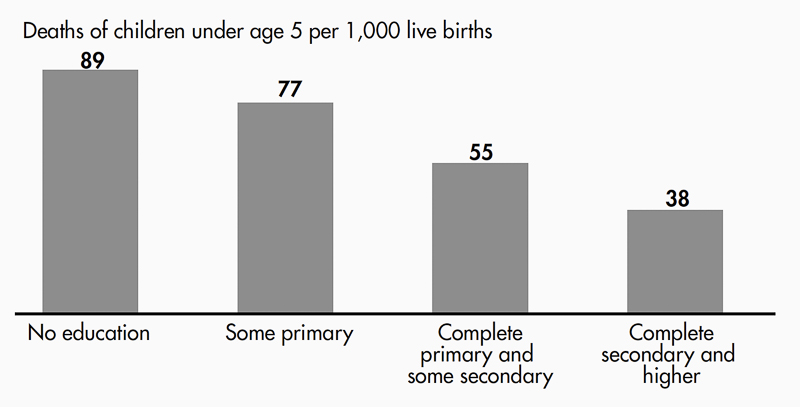
Source: ORC Macro, Egypt DHS, 2000.
Most women in the MENA region know something about modern contraception, but more-educated women tend to know about a wider range of available methods and where to get them. In Egypt, 69 percent of married women ages 15 to 49 who had completed secondary school reported seeing family planning messages in newspapers or magazines, compared with 32 percent of those who had completed only primary school.15 Women with more education are also more likely to discuss family planning issues with their husbands.
Women’s ability to choose the number and timing of their births is key to empowering women as individuals, mothers, and citizens, but women’s rights go beyond those dealing with their reproductive roles. Women should be able to fulfill their aspirations outside the home, to the benefit of themselves, their families, and their countries. Opening economic opportunities to women has far-reaching effects, but those benefits can be reaped only if women receive at least a basic education.
Employment
As women’s educational attainment in MENA countries has increased, more women have moved into the job market. But women’s participation in the labor force is still low: Only 20 percent of women ages 15 and older in MENA countries are in the labor force — the lowest level of any world region. The highest levels of native female labor force participation in MENA countries are found in Lebanon, Morocco, Turkey, and Yemen, where women constitute more than 25 percent of the labor force. But those rates are lower than rates found outside the region. In France, for example, women make up 45 percent of the labor force; in Indonesia, which is home to the world’s largest Muslim population, women make up 38 percent of the labor force.16 The lowest rates of labor force participation are seen among women native to the countries of the Gulf Cooperation Council, a group of six conservative monarchies; reported national rates are inflated by the large number of foreign female laborers in those countries.
Women who live in countries with a large agricultural sector, such as Egypt, Iran, Syria, and Yemen, tend to work mainly in that sector, although some MENA countries have been more successful in getting women into nonagricultural occupations. Morocco, Tunisia, and Turkey, for example, have been able to engage women in the countries’ export-manufacturing sectors.
Most of the MENA women who work outside the agricultural sector are college-educated professionals employed mainly in government (except in Lebanon, where the majority of the female labor force is found in the private sector).17 A smaller share of women work in factories, but many lack the educational qualifications of factory workers in countries such as China, Vietnam, and the nations of the former Soviet bloc.
The current high unemployment rates among men in MENA countries make it harder for women to compete in male-dominated job markets, and women’s unemployment rates are higher than those of men in the region. In Saudi Arabia, where Saudi women account for only 7 percent of the labor force, the unemployment rate for women in 1999 was 16 percent, more than double the unemployment rate for men.18 In 2000, the unemployment rate among urban Iranian women was 25 percent, compared with 16 percent for men; in rural areas of the country, women’s unemployment reached 20 percent, versus 17 percent for men.19 Improving the quality of education, providing more vocational training, developing job-creating programs, and removing obstacles to women’s entrepreneurship can help alleviate the high rates of female unemployment.
Ongoing Concerns
MENA countries have made significant strides in making education available over the past few decades, but challenges remain. Access to education has improved, and the illiteracy rate among the region’s young adults (people ages 15 to 24) is half that of the adult population (people ages 15 and up). More women are now pursuing higher education, reflecting their ability to graduate from secondary school. In some countries, such as the oil-rich Gulf states, women make up a larger share of university enrollment in part because many young men from those countries go abroad for college and graduate school.
But illiteracy remains high in some countries, there are still wide gender gaps in parts of the region, and the quality of the education is a major concern throughout the region.
Illiteracy
MENA countries’ illiteracy rates are often higher than those of non-MENA countries with comparable or lower per capita incomes (see Figure 4). There are over 75 million illiterate adults in the region, more than half of whom live in Egypt, Iraq, and Morocco. Around 13 million young adults are illiterate; fully one-third of them live in Egypt, which has both a high illiteracy rate and a large population. As in other parts of the world, illiteracy rates in the MENA region are higher among rural than among urban populations (see Figure 5 for an example).
Figure 4
Female Illiteracy Rates and per Capita Income in Selected Countries, 2000
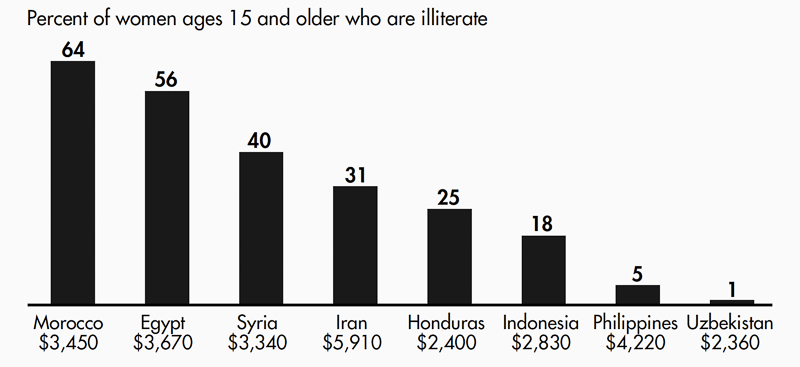 Source: UNESCO Institute for Statistics, “Literacy Statistics” (www.uis.unesco.org, accessed March 11, 2003); and World Bank, World Development Indicators 2002.
Source: UNESCO Institute for Statistics, “Literacy Statistics” (www.uis.unesco.org, accessed March 11, 2003); and World Bank, World Development Indicators 2002.
Figure 5
Egyptians Who Have Never Attended School, by Sex and Residence, 2000
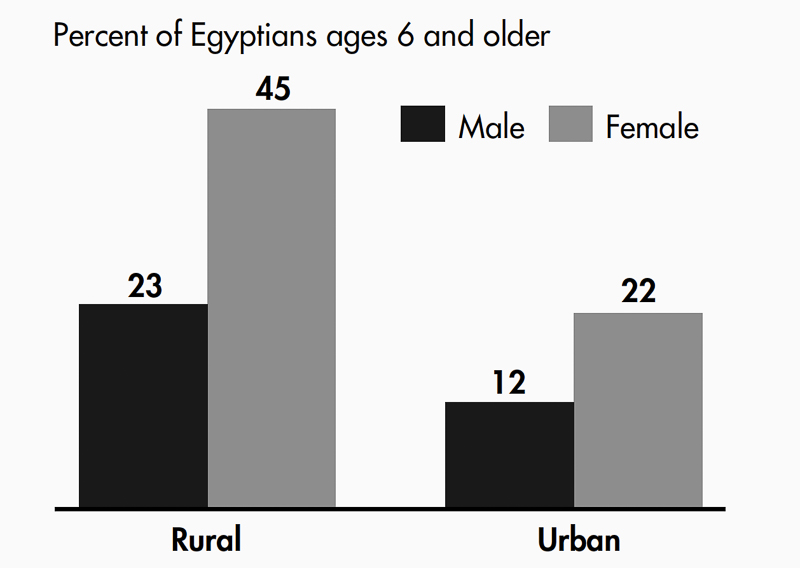
Source: ORC Macro, Egypt DHS, 2000.
Although all MENA governments require that all children receive at least five years of schooling and all provide free education at least through high school, the rapid growth of school-age populations in the region is posing a challenge for many governments. Between 1986 and 1996, for example, the number of Iranians between ages 5 and 19 grew by 20 percent, or nearly 4 million, straining the capacity of the country’s schools.20 In Egypt, despite the government’s success in reducing the adult illiteracy rate from 60 percent in 1980 to 50 percent in 1995, the increase in the population’s size meant that the number of illiterate Egyptians grew from 16 million to 19 million. A similar trend has been visible in Morocco.21
Gender Gaps
Women in MENA countries are twice as likely to be illiterate as men are and make up two-thirds of the region’s illiterate adults. The gender gaps in education vary greatly across countries in the region but are generally wider in countries where overall literacy and school enrollment are lower. In Yemen, for example, the illiteracy rate among young women (54 percent) is triple that of young men (17 percent). But countries that make political and financial commitments to reducing illiteracy, as Jordan and Tunisia have, generally see significant improvements in reducing illiteracy and narrowing the gender gap (see Figure 6).22
Figure 6
Closing the Gender Gap in Literacy in Jordan and Tunisia, 1970 and 2000
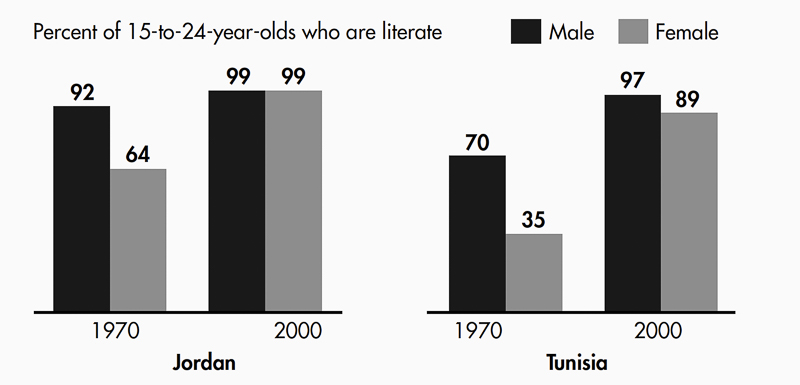
Source: UNESCO Institute for Statistics, “Literacy Statistics” (www.uis.unesco.org, accessed March 11, 2003).
Gender gaps in literacy and school enrollment generally persist regardless of rural or urban location. Gender gaps in school enrollment are especially wide in Egypt, Iraq, Turkey, and Yemen. Closing gender gaps in education would benefit countries’ economies. One study estimated that the region’s average annual growth in per capita gross national product would have been nearly a full percentage point higher between 1960 and 1992 if MENA’s gender gap in education had shrunk as quickly as East Asia’s did.23
Quality of Education
It is not enough to make education more widely available; the quality of the education also needs to be improved. Arguing that the poor quality of education in MENA countries has led to a significant mismatch between the labor market’s needs and graduates’ skills, the 2002 Arab Human Development Report points out that education in the region often fails to teach students to analyze information or think innovatively. The report also warns that education systems may split into two tiers, with high-quality private education available only to the wealthy minority and low-quality public education the sole option for most citizens. Such a trend would turn education into a “means of perpetuating social stratification and poverty” rather than a means of increasing social equality.24
Gender sensitivity is a key aspect of the quality of education. Educational systems should be sensitive to the specific needs of girls and women. Yet the curricula and teaching materials — and the media, which has a powerful role in shaping people’s knowledge and opinions — in the MENA region often reinforce traditional roles that may deny women opportunities for full and equal participation in society. As radio, television, and the Internet reach more people in the region, it becomes even more important that students learn to analyze and judge the media’s messages for themselves.
The Need for Action
Efforts to improve female education in MENA countries need to go beyond rhetoric and should involve policies and programs with measurable results. Governments can start by making the MDGs part of national development plans and monitoring progress toward those goals (see Box 1 at end of article). Governments also need to make an extra effort to ensure that education is more accessible to low-income families and rural populations, with special attention to the quality of the education provided and the need for girls to complete school.
Richer countries both inside and outside the region are encouraged to help resource-poor countries improve their educational systems and collect data on their progress. Improving access to and the quality of education is the most rewarding investment a country can make. Investing in female education will accelerate the MENA region’s economic and social development by enhancing human capital, slowing population growth, and alleviating poverty.
References
- United Nations Development Programme (UNDP), Arab Human Development Report 2002 (New York: UNDP, 2002): 54.
- United Nations (UN), Universal Declaration of Human Rights (New York: UN, 1948); and UN, International Conference on Population and Development Programme of Action (New York: UN, 1994): para. 4.18.
- UN, Platform of Action, Fourth World Conference on Women, Beijing, China, 4-15 September 1995 (New York: UN, 1996): para. 69; and UN, The Beijing Declaration (New York: UN, 1996): paras. 13, 14, and 17.
- UN, “Millennium Development Goals: About the Goals,” accessed online at www.developmentgoals.org/About_the_goals.htm, on May 15, 2003.
- United Nations Educational, Scientific, and Cultural Organization (UNESCO) Institute for Statistics, Financing Education — Investments and Returns, Analysis of the World Education Indicators, 2002 Edition: Executive Summary, accessed online at http://portal.unesco.org/
uis/TEMPLATE/pdf/wei/WEI_ExecSummary_Eng.pdf, on April 1, 2003. - Willem van Eeghen and Kouassi Soman, “Poverty in the Middle East and North Africa” (1997), accessed online at www.worldbank.org/
mdf/mdf1/menapoor.htm, on Jan. 6, 2003. - United Nations Population Fund (UNFPA), State of World Population 2002: People, Poverty, and Possibilities (New York: UNFPA, 2002).
- Daisy Dwyer and Judith Bruce, eds., A Home Divided: Women and Income in the Third World (Stanford, CA: Stanford University Press, 1988).
- Valentine M. Moghadam, Women, Work, and Economic Reform in the Middle East and North Africa (Boulder, CO: Lynne Rienner Publishers, 1998).
- Valentine M. Moghadam, Modernizing Women: Gender and Social Change in the Middle East, 2d ed. (Boulder, CO: Lynne Rienner Publishers, 2003); and Massoud Karshenas and Valentine M. Moghadam, “Female Labor Force Participation and Economic Adjustment in the MENA Region,” in The Economics of Women and Work in the Middle East and North Africa, ed. Mine Cinar (Amsterdam, Netherlands: JAI Press, 2001): 51-74.
- Fatma El-Zanaty and Ann Way, Egypt Demographic and Health Survey (DHS) 2000 (Calverton, MD: Ministry of Health and Population [Egypt], National Population Council, and ORC Macro, 2001): tables 15.10 and 15.3.
- El-Zanaty and Way, Egypt DHS, 2000: tables 4.9, 5.9, and 8.4.
- Turkey Demographic and Health Survey 1998 Final Report (Ankara, Turkey, and Calverton, MD, USA: Hacettepe University, Institute of Population Studies, and ORC Macro, 1999): table 3.9.
- El-Zanaty and Way, Egypt DHS, 2000: tables 9.9 and 11.5.
- El-Zanaty and Way, Egypt DHS, 2000: table 5.5.
- United Nations, The World’s Women 2000: Trends and Statistics, accessed online at http://unstats.un.org/unsd/demographic/
ww2000/table5d.htm, on March 27, 2003. - Institute for Women’s Studies in the Arab World, “Female Labor Force in Lebanon,” Al-Raida 15, no. 82 (1998): 12-23.
- Kevin R. Taecker, “Myths and Realities About Unemployment in Saudi Arabia,” Saudi-American Forum Essay 11 (March 30, 2003), accessed online at www.saudi-american-forum.org/Newsletters/
SAF_Essay_11.htm, on April 1, 2003. - UNFPA et al., “Simaie Jameeat va Salamat dar Johmorie Eslamie Iran,” Mehrmah 1379 (Tehran, Iran: UNFPA, 2000): table 3.4.
- Statistical Center of Iran, Iran Statistical Yearbook 1379 (Tehran, Iran: Statistical Center of Iran, 2001): table 2.2.
- UNESCO, UNESCO Statistical Yearbook 1999 (Paris: UNESCO, 1999): table II.2.
- May Rihani and Cynthia Prather, Strategies for Female Education in the Middle East and North Africa (Amman, Jordan: United Nations Children’s Fund, 1993)
- World Bank, Engendering Development: Through Gender Equality in Rights, Resources, and Voice (Washington, DC: World Bank, 2001): 90-91.
- UNDP, Arab Human Development Report 2002: 53-54.

